From the tiniest microbes that populated Earth billions of years ago to the various new species scientists are still discovering, today’s organisms have survived by braving nature’s trials and tribulations.
Skirting death requires evolutionary creativity. Here are eight animals who employ unique and strange strategies to survive in the wild.
Read more: 5 Unique Ways Animals Avoid Getting Eaten
1. Bombardier Beetles: Chemical Warfare
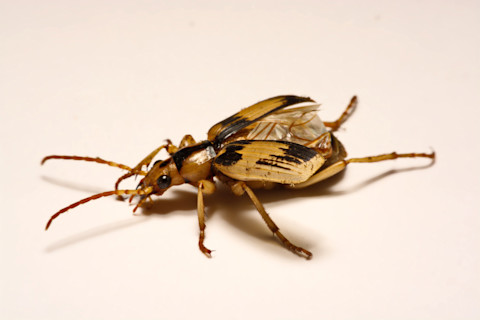
(Credit: KASIRA SUDA/Shutterstock)
KASIRA SUDA/Shutterstock
The bombardier beetle earns its name for its unique chemical defense. Their bodies hold multiple compartments for in-house chemical reactions, right on demand. When threatened, the muscles surrounding a chamber known as the reservoir compartment contract, sending its contents through a one-way valve into the neighboring reaction chamber.
Inside this chamber, chemicals mix with enzymes, jump-starting a reaction that heats up to 100 degrees Celsius. Utilizing an ejection style similar to that of German World War II “buzz” bombs, this burning and stinky concoction shoots out the tip of the bombardier’s abdomen at hundreds of spurts per second. It aims the liquid ammo with stunning marksmanship at whomever’s unlucky enough to be at the tail-end of it.
Even Charles Darwin fell victim to the blast when he held a close relative of the bombardier beetle between his teeth while attempting to catch another specimen, documenting, “To my unspeakable disgust and pain the little inconsiderate beast squirted his acid down my throat.”
2. Horned Lizards: Squirting Blood
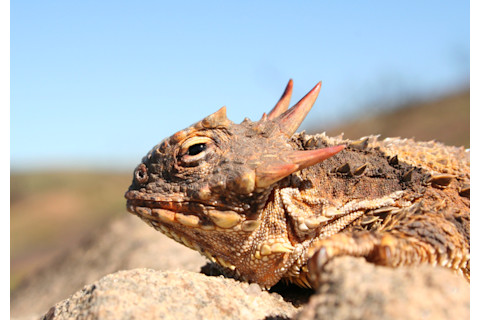
(Credit: Creeping Things/Shutterstock)
Creeping Things/Shutterstock
This spiky lizard, sporting a heavy crown of horns adorning its head, has one gnarly mode of self-defense: squirting jets of blood out its eyes.
The horned lizard has an arsenal of natural predators, from birds of prey, like hawks, to canines, like wolves and dogs. If approached by one, it might inflate its body and openly display its spikes – not dissimilar to a pufferfish.
Horned lizards will also fight for their lives by ejecting a noxious spray of blood right out their eyes, a powerful stream that can land up to 3 feet away. The lizard accomplishes this by upping its internal blood pressure tremendously, rupturing blood vessels around its eyes and causing its ocular sinuses to bulge and swell.
After enough pressure, an unfortunately peckish wolf might get a mouthful of foul-tasting blood instead. But don’t worry – the lizard gets away just fine.
3. Sloths: Taking It Slow

(Credit: Milan Zygmunt/Shutterstock)
Milan Zygmunt/Shutterstock
While some may compare the sloth to the DMV, these animals aren’t actually as dense as popular culture might have you thinking. In fact, some scientists say a sloth’s slowness is actually its survival tactic. After all, its survival after millions of years is proof of its success.
Sloths hang from trees and do most of their business upside down. They sleep for many hours a day and snack on leaves. Because they spend so much of their time sedentary, sloths don’t require or expend much energy. In fact, it can take a month for a sloth to digest a single meal.
You might wonder how sloths protect themselves if they’re this slow. That lethargy is advantageous, as their predators, such as jaguars, detect prey by movement. Sloths move so slowly that they can evade a jaguar’s prying eye. Further shielding them in plain sight is the natural camouflage of their fur, tinted by blue-green algae.
Read more: The Furry Ecosystem of Algae, Moths and Sloth Feces
4. Sea Cucumbers: Evisceration
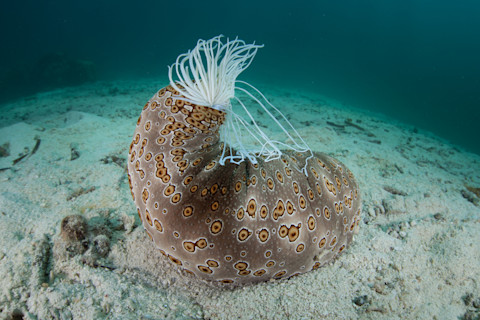
(Credit: Ethan Daniels/Shutterstock)
Ethan Daniels/Shutterstock
The defense of these seafloor dwellers essentially rids them of their internal organs, a move appropriately dubbed “evisceration.”
By expelling its viscera, the sea cucumber can buy itself time to crawl away from threats and seek safety. Though this serves as a distraction tactic, sea cucumbers may eject their innards simply when stressed or when environmental conditions aren’t favorable. They can even do it as a mode of self-cleaning – after spending their waking moments consuming the ocean’s detritus, a gut-cleansing is helpful.
Surprisingly, the forceful expulsion of its organs isn’t fatal to the sea cucumber. According to the Monterey Bay Aquarium, it can regenerate them within two to four weeks.
5. Jellyfish: Immortality

(Credit: S. Kuelcue/Shutterstock)
S. Kuelcue/Shutterstock
One species of jellyfish, named Turritopsis dohrnii, has a peculiar way of cheating death: by cheating death.
Jellyfish go from larval form to a colony of polyps, which later mature into medusae – the bell-headed forms we all know and love. Where T. dohrnii differs is if a tiny medusa sustains any damage or stress, it can regress back into its polyp stage. This jellyfish reabsorbs its tentacles and sinks to the ocean bottom, resembling a cyst on the floor.
After a period of 24 to 36 hours, it begins developing the classic traits of polyps, eventually budding off as a new cohort of medusae – all descended from an originally injured adult.
T. dohrnii accomplishes this through a process called cellular transdifferentiation. Through transdifferentiation, any cell can become a different cell. The cells specialized for medusae are reprogrammed into cells distinct for polyps – so the T. dohrnii recreates its body from a previous life stage.
Understandably, the T. dohrnii is nicknamed the “immortal jellyfish,” though it’s not wholly invincible to death. It just has a way of avoiding it for much longer.
Read more: 5 Ancient Animals That Stood The Test Of Time
6. Cordyceps: Zombie-ification
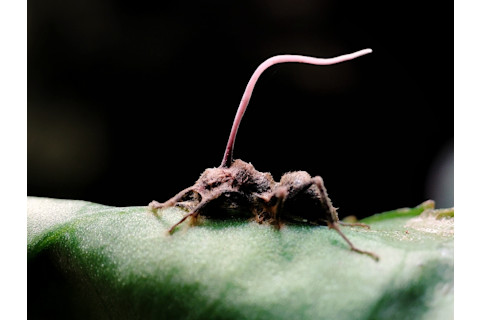
(Credit: Jojo dexter/Shutterstock)
Jojo dexter/Shutterstock
We’ve long been morbidly fascinated with the idea of a zombie virus. This parasitic fungus is a real example of one (kind of).
The Ophiocordyceps unilateralis – often referred to as “cordyceps” though it’s part of a different genus – targets carpenter ants roaming tropical forest floors. Infection begins when an unsuspecting ant accidentally brushes against the cordyceps’ deadly spores.
When the fungus attaches to and penetrates the ant’s exoskeleton, it doesn’t directly seep into its brain. Instead, it invades the ant’s muscles and produces compounds meddling with its nervous system.
Over the course of several weeks, the infected ant grows aimless and confused, convulsing and behaving strangely. It abandons its colony as the fungus directs it to a microclimate ideal for reproduction – usually a plant close to the forest floor. The final stage of infection is the death bite, where the ant locks its jaw onto the plant and awaits its end.
A stalk erupting through the ant’s skull marks the cordyceps’ victory, from where it continues releasing spores to claim its next victim.
(It’s not hopeless for carpenter ants, who’ve developed their own strategies to avoid zombie-ification – including social grooming and even evicting anyone who starts acting unusual.)
Read more: Real Life Zombies: Fact or Fiction?
7. Tardigrades: Cryptobiosis

(Credit: Denis---S/Shutterstock)
Denis---S/Shutterstock
These adorably rotund water bears are the darlings of the microscopic world. One reason for their popularity is their hardiness – in fact, scientists believe tardigrades are one of the few species that will outlive humans and apocalypses.
How is this possible? Tardigrades survive in the harshest conditions known to humans by entering “cryptobiosis.” They expel over 95 percent of the water in their bodies and curl into a small tun, resembling a lifeless roly-poly ball. In this state, tardigrades’ metabolic activity slows to a mere crawl, while specialized proteins swathe and protect their cells.
Water bears aren’t actually extremophiles, more extremo-tolerant. Regular tardigrades, who toddle about practically everywhere on Earth, can’t withstand temperatures as high as they could in cryptobiosis. But as tuns, they could survive for years, even in the cold vacuum of outer space.
Read more: Can the Cute Tardigrade Survive in Space?
8. Hairy Frogs: Wolverine?!
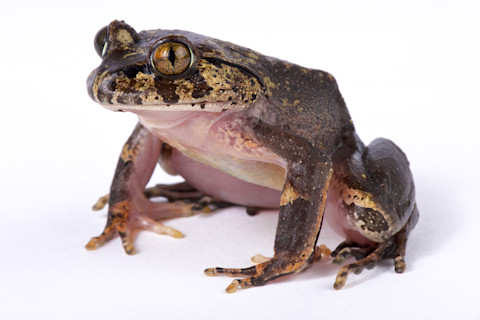
(Credit: reptiles4all/Shutterstock)
reptiles4all/Shutterstock
These frogs sport strings of hairlike strands on their bodies, resembling a cowboy’s chaps. Despite the “hairy” moniker, they’re actually blood vessel-rich strands that temporarily boost breathing capacity.
That’s not their main defense, though. Hairy frogs have another nickname: the horror frog. This is because their go-to defense is to break their own bones into sharp claws.
By flexing certain muscles in their feet, hairy frogs forcefully rip their claws through their skin. Once their claws are exposed, hairy frogs use powerful, slashing kicks to ward off their attackers, inflicting deep, bleeding lacerations.
These are the only vertebrate claws known to “pierce their way into functionality,” according to a 2008 study published in Biology Letters. And they’re effective. Cameroonians, who hunt these frogs, have taken to using spears and machetes to avoid getting sliced.
Talk about hardcore.
Read more: 6 Animals With Unusual Evolutionary Traits















